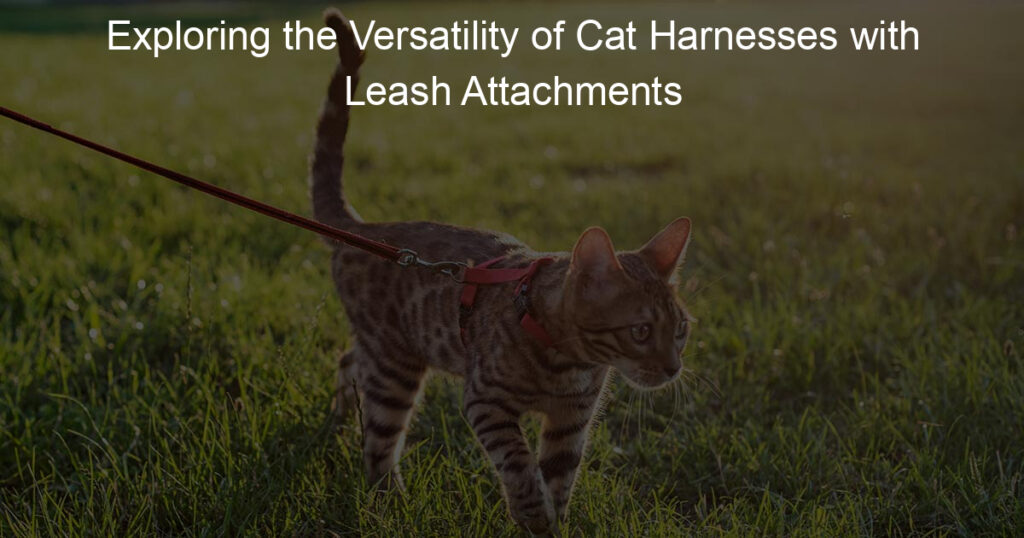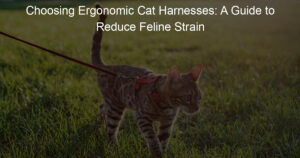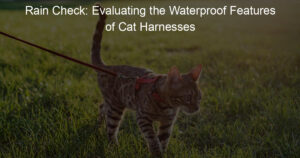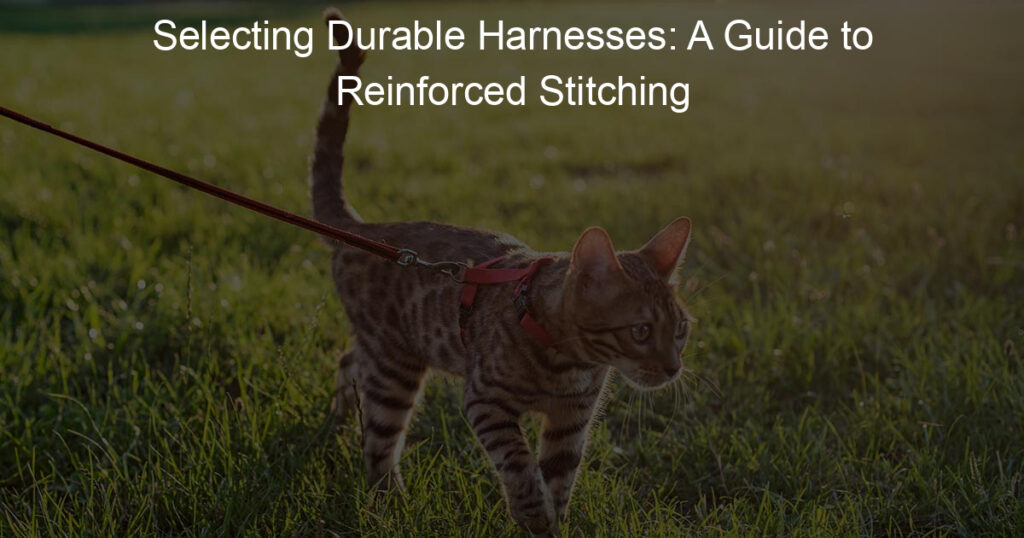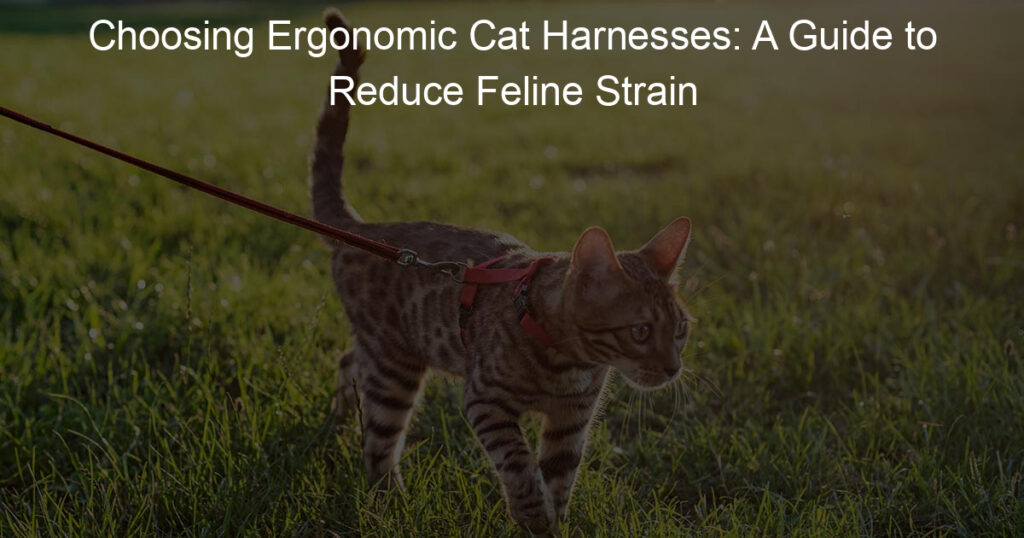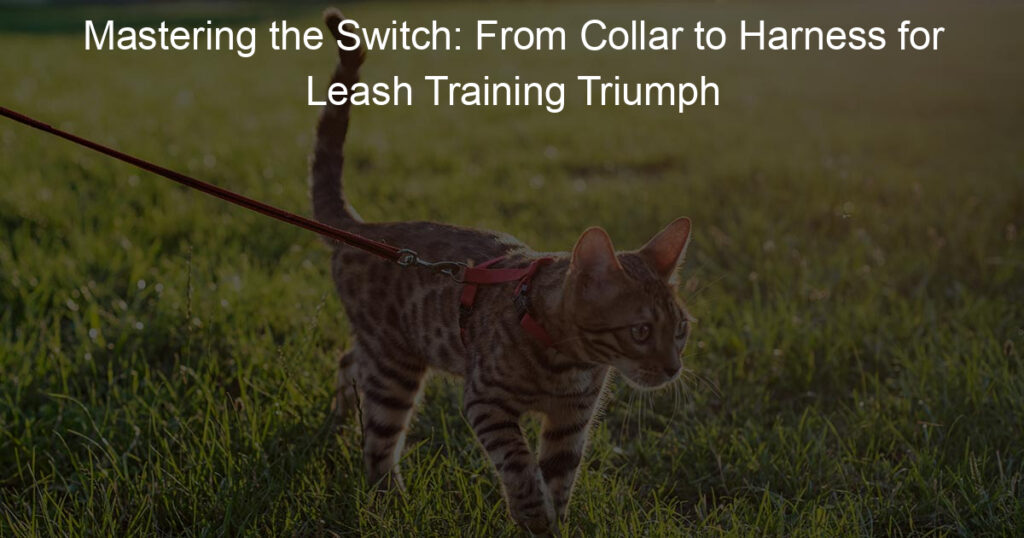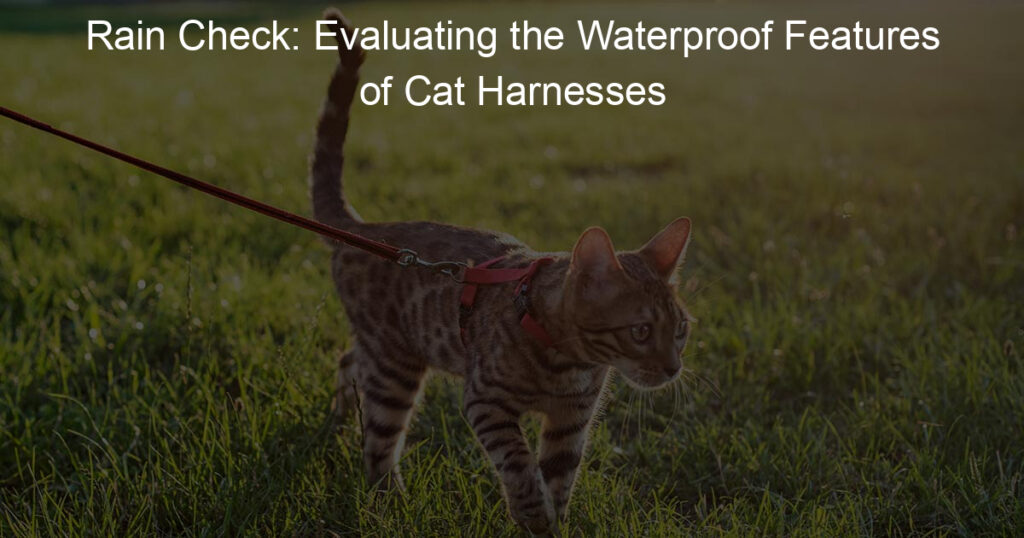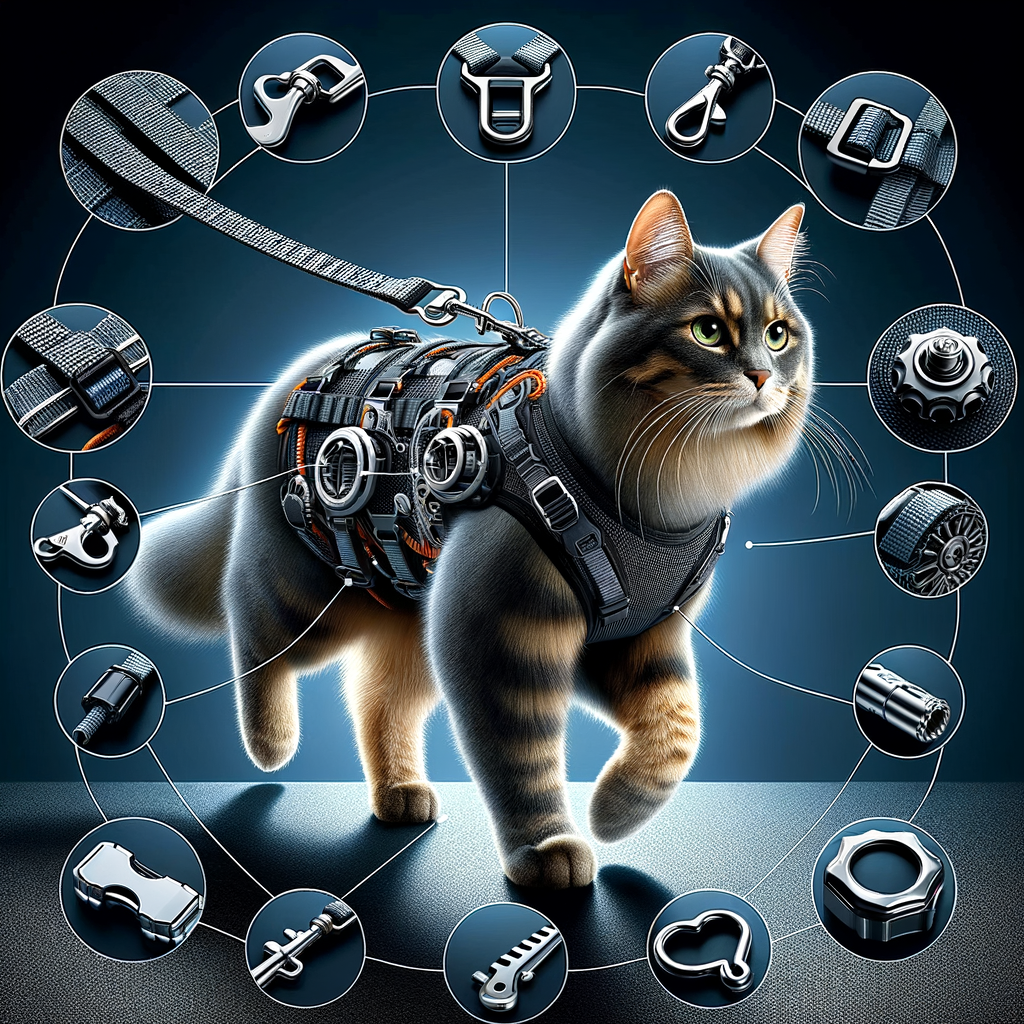
Introduction to Cat Harness Versatility
When it comes to our feline friends, ensuring their safety and comfort is paramount. One way to achieve this is through the use of a versatile cat harness. This introductory section will delve into the importance of a versatile cat harness and the benefits of using a cat harness with leash attachments.
- Understanding the need for a versatile cat harness
- Benefits of using a cat harness with leash attachments
A versatile cat harness is not just a luxury, but a necessity for cat owners. Cats are naturally curious creatures and love to explore their surroundings. However, this curiosity can sometimes lead them into potentially dangerous situations. A versatile cat harness allows you to have control over your cat’s movements, ensuring their safety while still allowing them the freedom to explore.
Moreover, a versatile cat harness is designed to fit comfortably on your cat, reducing the risk of them feeling trapped or uncomfortable. It is adjustable to fit cats of different sizes and breeds, making it a practical choice for all cat owners.
Using a cat harness with leash attachments comes with a plethora of benefits. Firstly, it provides an additional layer of control, allowing you to guide your cat’s movements more effectively. This is particularly useful in outdoor environments where there may be potential hazards such as traffic or other animals.
Secondly, a cat harness with leash attachments can help in training your cat. It can be used to teach them boundaries and to follow commands, making your outdoor adventures together more enjoyable and stress-free.
Lastly, using a cat harness with leash attachments can also promote bonding between you and your cat. It allows you to engage in activities together such as walking or hiking, fostering a deeper connection and mutual trust.
In the following sections, we will explore different types of cat harnesses, how to choose the right one for your cat’s activities, and how to use a cat harness with leash attachments effectively. We will also share some case studies on harness attachment points for cats, and conclude with a discussion on the versatility of cat harnesses with leash attachments.
Exploring Different Cat Harnesses
When it comes to cat harnesses, there is a wide variety to choose from. Each type of harness has its own unique features and benefits. Let’s delve into the world of cat harnesses and explore the different types available.
Types of Cat Harnesses
There are three main types of cat harnesses: traditional, vest, and step-in. Each type has its own unique design and benefits. Let’s take a closer look at each one.
- Traditional Cat Harness
The traditional cat harness is the most common type. It usually consists of two loops: one for the neck and one for the chest. The leash is typically attached at the back. This type of harness is adjustable and can fit cats of various sizes. However, some cats may find it uncomfortable and may try to wriggle out of it.
- Vest Cat Harness
The vest cat harness, also known as a jacket or holster harness, is designed to provide more comfort for your cat. It covers a larger area of the cat’s body, distributing the pressure more evenly. This type of harness is often made of soft, breathable material, making it a good choice for cats with sensitive skin.
- Step-in Cat Harness
The step-in cat harness is the easiest to put on. As the name suggests, your cat simply steps into the harness, and you fasten it at the back. This type of harness is ideal for cats who dislike having something pulled over their head. However, it may not provide as much control as the other types of harnesses.
Choosing the right harness for your cat depends on your cat’s size, temperament, and comfort level. It’s always a good idea to try different types of harnesses to see which one your cat prefers.
Understanding Leash Attachment Points
When it comes to cat harnesses, it’s important to understand the different leash attachment points. These are the spots where you clip the leash onto the harness. There are two main types of leash attachment points: front and back.
- Front Leash Attachment
The front leash attachment is located on the chest area of the harness. This type of attachment is designed to give you more control over your cat’s movements, especially if they have a tendency to pull or dart off in different directions. By attaching the leash at the front, you can guide your cat gently without causing them any discomfort.
- Back Leash Attachment
The back leash attachment is located on the back of the harness, usually between the shoulder blades. This type of attachment is more traditional and is often used for cats that are comfortable with walking on a leash. It allows your cat to move more freely, but still gives you control if needed.
Both front and back leash attachments have their own advantages and can be used in different situations. It’s important to choose the right attachment point based on your cat’s behavior and comfort level.
| Leash Attachment Point | Advantages |
|---|---|
| Front Leash Attachment | Provides more control, good for cats that pull or dart off |
| Back Leash Attachment | Allows more freedom, good for cats comfortable with leash walking |
In conclusion, understanding leash attachment points can help you make the most out of your cat harness. Whether you choose a front or back leash attachment, always ensure your cat is comfortable and safe.
Choosing the Right Cat Harness for Activities
When it comes to choosing the right cat harness for activities, there are several factors to consider. These factors will ensure that your cat is comfortable, safe, and ready for any adventure.
Considerations when selecting a cat harness
Here are the top three considerations to keep in mind when selecting a cat harness:
- Size and Fit
- Material and Durability
- Leash Attachment Points
It’s crucial to choose a harness that fits your cat perfectly. A harness that’s too tight can cause discomfort and restrict movement, while a loose one can be a safety hazard as your cat might slip out of it. Measure your cat’s neck and chest circumference before purchasing a harness. Most manufacturers provide a sizing chart, so use that as a guide.
The material of the harness plays a significant role in its durability. Look for a harness made from high-quality, durable materials like nylon or leather. These materials can withstand the wear and tear of outdoor activities and last longer. Additionally, they should be lightweight and breathable for your cat’s comfort.
Leash attachment points are another important consideration. Some harnesses have a single attachment point on the back, while others have multiple points. Multiple attachment points can provide more control, especially for active cats. However, a single attachment point is usually sufficient for indoor activities or calm cats.
By considering these factors, you can ensure that your cat is comfortable and safe during activities. Remember, the right harness can make all the difference in your cat’s comfort and safety.
Different Activities for Cats
When it comes to keeping our feline friends happy and healthy, it’s important to provide them with a variety of activities. Cats are naturally curious and active creatures, and they need both mental and physical stimulation to stay in top shape. Let’s explore some indoor and outdoor activities that you can enjoy with your cat, using the right cat harness.
- Indoor activities
Indoor activities are perfect for those days when it’s too cold or rainy to venture outside. Here are a few ideas:
- Playtime with toys: Cats love to play, and toys can keep them entertained for hours. Try a variety of toys, like balls, feather wands, or laser pointers. Remember to always supervise playtime, especially when using toys with small parts.
- Exploring new spaces: Cats are curious creatures and love to explore new spaces. You can create an indoor adventure for your cat by rearranging furniture or introducing new objects for them to investigate.
- Treat puzzles: Treat puzzles are a great way to stimulate your cat’s mind and satisfy their natural hunting instincts. Hide treats in a puzzle toy and watch your cat have fun figuring out how to get them.
- Outdoor activities
Outdoor activities can provide a whole new world of stimulation for your cat. Here are some safe and fun outdoor activities:
- Leash walks: With a well-fitted cat harness and leash, you can take your cat for walks in the garden or even at the park. Always keep a close eye on your cat to ensure their safety.
- Exploring the backyard: If you have a secure backyard, let your cat explore under your supervision. They’ll love investigating all the smells, sounds, and sights.
- Outdoor playtime: Similar to indoor play, outdoor play can involve toys. Consider toys that can be easily seen outdoors, like brightly colored balls or feather wands.
Remember, no matter what activity you choose, safety should always be your top priority. Always supervise your cat during these activities and ensure they are wearing a well-fitted harness.
How to Use a Cat Harness with Leash Attachments
Learning how to use a cat harness with leash attachments can be a game-changer for your feline friend. It can provide them with the freedom to explore the outside world safely. Let’s delve into how you can train your cat to use a harness.
Training Your Cat to Use a Harness
Training your cat to use a harness involves three main steps. These steps are designed to ensure your cat feels comfortable and safe while wearing the harness.
- Introducing the Harness
- Getting Your Cat Comfortable with the Harness
- Practicing with the Leash Attachment
The first step is to introduce the harness to your cat. Place the harness near your cat’s favorite spot and let them sniff and explore it. This helps your cat to get used to the new object.
Once your cat is familiar with the harness, the next step is to get them comfortable wearing it. Start by placing the harness on your cat without fastening it. Allow them to wear it for short periods while rewarding them with treats and praise. Gradually increase the time your cat spends in the harness.
After your cat is comfortable wearing the harness, it’s time to introduce the leash. Attach the leash to the harness and let your cat drag it around under your supervision. Once they’re used to the leash, you can start holding it during their exploration sessions. Remember to keep the first few sessions short and positive.
Training your cat to use a harness requires patience and consistency. But with time, your cat will learn to associate the harness with positive experiences, making it easier for both of you.
Safe Use of Cat Harness and Leash
Ensuring the safety of your feline friend while using a cat harness and leash is paramount. This involves careful monitoring and addressing potential issues promptly. Let’s delve into these aspects in detail.
- Monitoring Your Cat While Harnessed
- Preventing and Addressing Potential Issues
When your cat is harnessed and leashed, it’s important to keep a close eye on them. Cats are curious creatures and may attempt to explore areas that could pose a risk. Watch for signs of discomfort or distress, such as excessive meowing, panting, or trying to escape from the harness. If your cat shows any of these signs, it’s best to remove the harness and give them a break.
Prevention is always better than cure. To prevent potential issues, ensure the harness fits your cat properly. It should be snug but not tight, allowing you to fit two fingers between the harness and your cat’s body. Regularly check the harness for any signs of wear and tear, replacing it if necessary.
Despite your best efforts, issues may still arise. Your cat might get tangled in the leash or the harness might chafe their skin. In such cases, remain calm and gently untangle the leash or adjust the harness. If the problem persists, consult with a veterinarian or a professional cat trainer for advice.
In conclusion, the safe use of a cat harness and leash involves careful monitoring and proactive problem-solving. With patience and practice, you and your feline friend can enjoy safe and enjoyable outdoor adventures together.
Case Studies: Harness Attachment Points for Cats
Let’s delve into some real-life examples to better understand the practical use of cat harnesses with leash attachments. We will begin with an indoor case study.
Case Study 1: Indoor Cat Harness Use
Meet Whiskers, a playful and curious indoor cat. Whiskers’ owner, Jane, decided to introduce a harness to Whiskers’ daily routine for safety and enrichment purposes. Here’s how it went.
Selection of the Harness: Jane chose a soft, adjustable harness with a secure leash attachment point. She made sure it was comfortable for Whiskers and wouldn’t restrict his movements.
Introduction and Training: Jane introduced the harness gradually. She started by leaving it near Whiskers’ favorite spots, allowing him to sniff and get used to it. After a few days, she began putting it on Whiskers for short periods, gradually increasing the time.
Indoor Exploration: Once Whiskers was comfortable with the harness, Jane attached the leash. She guided him around the house, letting him explore new areas like the basement and attic. Whiskers enjoyed these new adventures, and the leash ensured he was safe.
Benefits: Jane noticed that Whiskers became more active and curious. He seemed happier and more content with his indoor environment. The harness also provided a safe way to control Whiskers during necessary events like vet visits.
| Key Points | Details |
|---|---|
| Selection of Harness | Soft, adjustable, and comfortable with a secure leash attachment point. |
| Introduction and Training | Gradual introduction, starting with familiarization, then short periods of wear, gradually increasing over time. |
| Indoor Exploration | Guided exploration of new areas in the house with the leash attached for safety. |
| Benefits | Increased activity and curiosity, improved happiness and contentment, safe control during necessary events. |
In conclusion, using a harness with a leash attachment point for indoor cats like Whiskers can enhance their quality of life. It provides safety, control, and new opportunities for exploration and enrichment.
Case Study 2: Outdoor Cat Harness Use
Let’s take a look at a real-life example of how an outdoor cat harness can be beneficial. This case study involves a cat named Whiskers who loves to explore the great outdoors.
Background: Whiskers is a 3-year-old domestic short-haired cat. Her owners live in a suburban area with a large backyard. They wanted Whiskers to enjoy the outdoors safely, so they decided to use a cat harness.
| Details | Information |
|---|---|
| Cat’s Name | Whiskers |
| Age | 3 years |
| Type of Harness Used | Outdoor Cat Harness with Leash Attachments |
Experience: Whiskers’ owners started by slowly introducing her to the harness indoors. Once she was comfortable, they took her outside. They found that the harness gave them control over Whiskers’ movements, preventing her from running into the street or climbing trees. It also allowed Whiskers to explore her surroundings safely.
Outcome: Whiskers now enjoys her outdoor adventures while her owners have peace of mind. They are happy with their decision to use an outdoor cat harness and recommend it to other cat owners.
In conclusion, this case study highlights the benefits of using an outdoor cat harness. It provides safety for the cat and peace of mind for the owners. It’s a win-win situation!
Conclusion: The Versatility of Cat Harnesses with Leash Attachments
As we reach the end of our exploration into the world of cat harnesses with leash attachments, it’s clear that these tools offer a wide range of benefits for both cats and their owners. They provide safety, control, and a unique way to bond with your feline friend. Let’s take a moment to recap the key points and share some final thoughts on the versatility of cat harnesses.
- Recap of key points
- Final thoughts on cat harness versatility
We’ve learned that cat harnesses come in a variety of styles, each with its own unique features. Some are designed for comfort, while others prioritize safety or control. We’ve also discovered that choosing the right harness depends on your cat’s size, temperament, and the activities you plan to do together.
Using a cat harness with a leash attachment can be a game-changer. It allows you to take your cat for walks, hikes, or even on adventures in the great outdoors. We’ve seen through various case studies how harness attachment points can make a significant difference in a cat’s comfort and safety.
The versatility of cat harnesses with leash attachments cannot be overstated. They offer a unique way for cats to explore their surroundings while keeping them safe. Whether you’re taking your cat for a walk around the neighborhood, going on a hiking adventure, or simply giving them some outdoor time in a controlled environment, a cat harness with a leash attachment is an invaluable tool.
Remember, every cat is unique. What works for one might not work for another. It’s important to take your time, do your research, and find the harness that best suits your cat’s needs. With patience and the right harness, you and your feline friend can embark on many exciting adventures together.
In conclusion, cat harnesses with leash attachments are versatile tools that can greatly enhance your cat’s quality of life. They provide a safe and controlled way for your cat to explore the world, while also offering you peace of mind. So why wait? Start your adventure today!

